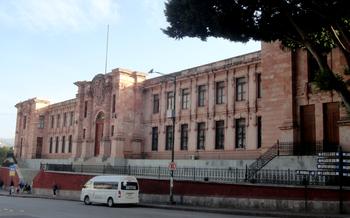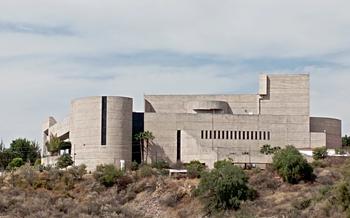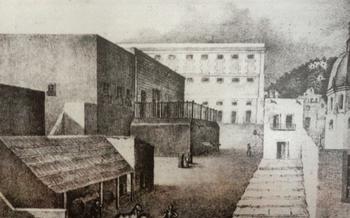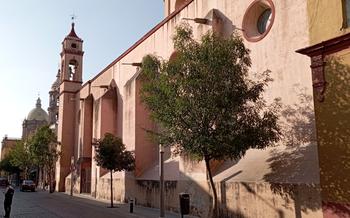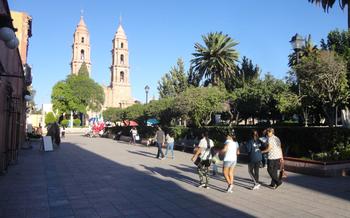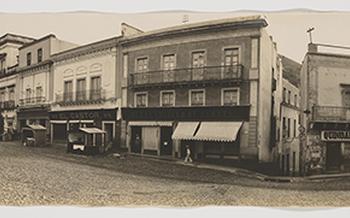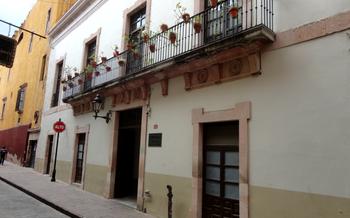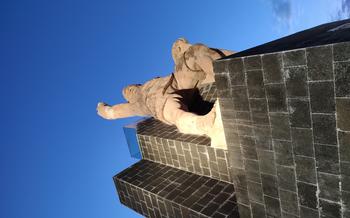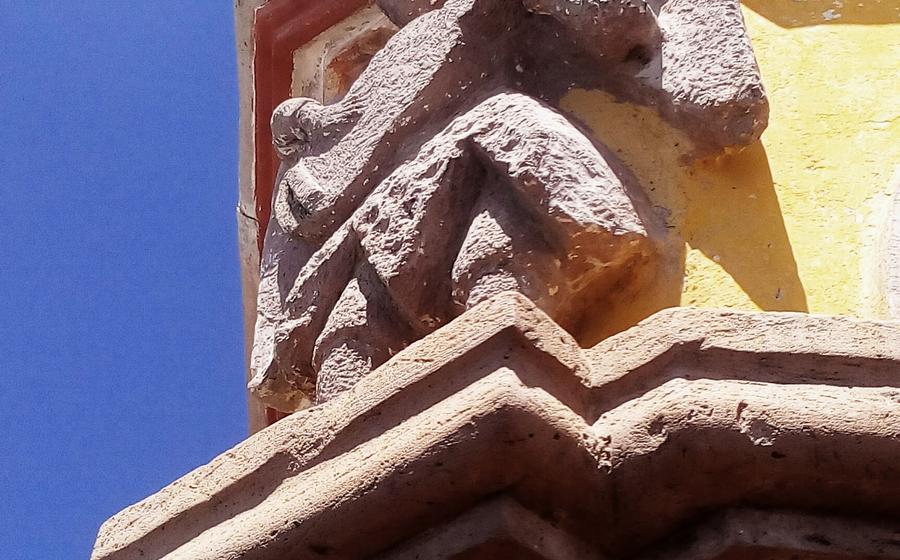
Templo del Señor de la Conquista
- The Legend of the Señor de la Conquista
- The Templo's Exterior and Surroundings
- The Templo's Role in the Community
- Tips for Planning Your Visit
- Unveiling the Hidden Stories
- The Templo's Artistic Treasures
- Preservation and Restoration Efforts
- The Templo as a Symbol of Faith
- The Templo's Contribution to Tourism
- The Templo and the City's Identity
- Experiencing the Templo's Traditions
- Insider Tip: Hidden Gems and Secret Spots
The Legend of the Señor de la Conquista
According to legend, the image of the Señor de la Conquista was discovered in a mine near Guanajuato in the 17th century. A miner named Juan de la Cruz found a small, wooden cross with a figure of Christ attached to it. He took the cross home with him, and soon after, his wife was cured of a serious illness. Word of the miraculous healing spread, and soon people from all over the region were coming to see the cross and pray for its healing powers.
The legend of the Señor de la Conquista has had a profound impact on the identity of Guanajuato. The city is known as the "City of the Silver Cross" and the Señor de la Conquista is considered its patron saint. Every year, on the first Friday of Lent, a large festival is held in honor of the saint. The festival includes a procession through the streets of Guanajuato, where the image of the Señor de la Conquista is carried on a silver litter.
The Templo's Exterior and Surroundings
The Templo del Señor de la Conquista stands as a magnificent spectacle, captivating visitors with its intricate façade that reflects the architectural prowess of its time. Intricate carvings adorn the exterior, narrating stories from the Bible and the life of Jesus Christ. The main entrance, framed by a grand arch, invites visitors into the sacred space within.
The surrounding plaza, known as the Jardín de la Unión, serves as a vibrant gathering place for locals and tourists alike. This historical square, lined with colonial-era buildings, exudes an old-world charm. Visitors can take a leisurely stroll, soak in the ambiance, and admire the harmonious blend of architecture that surrounds the temple.
Climbing the temple's bell tower offers breathtaking panoramic views of the city. From this vantage point, visitors can admire the intricate rooftops, colorful facades, and the surrounding mountains that cradle Guanajuato. The views from the bell tower provide a unique perspective, allowing visitors to appreciate the city's unique layout and its rich architectural heritage.
Within walking distance of the temple, visitors can explore a wealth of nearby attractions. The Alhóndiga de Granaditas, a former granary turned museum, showcases the city's history and role in the Mexican War of Independence. The Teatro Juárez, a grand opera house, offers a glimpse into Guanajuato's vibrant arts scene. These attractions, along with the Templo del Señor de la Conquista, form a cultural triangle that provides a comprehensive exploration of the city's heritage.
The Templo's Role in the Community
The Templo del Señor de la community life in Guanajuato. Its role extends far beyond its spiritual significance, deeply intertwining with the city's cultural fabric.
The temple serves as a venue for various community events and gatherings, fostering a sense of unity and belonging among the locals. From traditional religious festivals to cultural celebrations, the temple's spacious interior and picturesque surroundings provide a welcoming backdrop for these joyous occasions.
Beyond its religious and cultural significance, the temple has a profound impact on the local economy. As a major tourist attraction, the temple draws visitors from near and far, contributing to the city's tourism industry. The influx of visitors not only generates revenue but also creates employment opportunities, benefiting the local community.
Furthermore, the temple collaborates closely with local organizations, working together to support social and charitable initiatives. Whether it's providing assistance to those in need or promoting educational programs, the temple actively engages with the community, demonstrating its commitment to the well-being of Guanajuato's residents.
Tips for Planning Your Visit
To make the most of your visit to the Templo del Señor de la Conquista, it's essential to plan ahead and consider a few practical tips.
Best Time to Visit:
- Avoid peak tourist season (December-January) for smaller crowds.
- Consider visiting during the city's annual festival (October) for a vibrant atmosphere.
- Weekdays (except Friday) are generally quieter than weekends for a more peaceful experience.
Dress Code and Etiquette:
- Dress respectfully, covering shoulders and knees.
- Silence mobile phones and avoid loud conversations to maintain a sacred ambiance.
- Be mindful of local customs and traditions, showing respect for religious practices.
Photography and Restrictions:
- Photography is usually permitted inside the temple, but using flash is often restricted.
- Respect the privacy of others and avoid taking photos during religious ceremonies.
- Ask permission before photographing individuals, especially during prayer or contemplation.
Accessibility:
- The temple is wheelchair accessible, with ramps and elevators providing easy access to all levels.
- Accessible restrooms are available for visitors with disabilities.
- Assisted listening devices are provided for those with hearing impairments.
Unveiling the Hidden Stories
The Templo del Señor de la Conquista has accumulated a wealth of hidden stories and legends over the centuries, adding to its mystique and allure. Visitors can uncover these hidden narratives by delving into the temple's rich history and engaging with the local community. Stories of famous visitors who have graced the temple's halls, such as renowned artists, religious figures, and historical personalities, add to its significance. Myths and legends surrounding the temple and its patron saint, passed down through generations, create an aura of mystery and intrigue. Furthermore, local traditions and beliefs associated with the temple offer a glimpse into the cultural and spiritual depth of the region. Exploring the temple's role in local folklore and literature reveals how it has become an integral part of the city's identity and storytelling tradition.
The Templo's Artistic Treasures
The Templo del Señor de la Conquista is a treasure trove of significant artwork that reflects the rich artistic history and cultural heritage of Mexico. Notable paintings, sculptures, and stained glass windows adorn the temple's interior, each telling a unique story and contributing to the church's overall aesthetic splendor.
The paintings, often depicting biblical scenes and religious figures, showcase the talent and skill of renowned Mexican artists from different eras. The vibrant colors and intricate details bring the stories to life, creating a profound visual experience for visitors.
The sculptures, carved from wood, stone, or metal, exhibit a mastery of form and expression. They depict saints, angels, and other religious figures with intricate details, capturing their essence and conveying a sense of awe and reverence.
The stained glass windows, with their vibrant hues and intricate patterns, filter the sunlight, creating a kaleidoscope of colors that illuminate the temple's interior. They depict religious scenes, biblical stories, and symbolic motifs, adding a touch of ethereal beauty to the sacred space.
These artistic treasures not only enhance the temple's visual appeal but also hold historical and cultural significance. They reflect the evolution of Mexican art, the influence of different artistic styles and periods, and the deep-rooted religious traditions of the region.
Preservation and Restoration Efforts
The Templo del Señor de la Conquista, with its centuries-old history and architectural grandeur, faces the continuous challenge of preservation. Over time, the effects of weather, pollution, and natural wear and tear have taken their toll on the structure.
To address these challenges, ongoing restoration projects are meticulously carried out to maintain the temple's integrity and beauty. These projects involve the collaboration of skilled artisans, craftsmen, and experts in the field of heritage conservation.
The restoration efforts prioritize the preservation of the temple's original features while incorporating modern techniques to ensure its stability and longevity. The restoration work encompasses cleaning and repairing stonework, restoring intricate carvings, and maintaining the vibrant colors of the temple's interior.
The involvement of local artisans and craftsmen plays a crucial role in these restoration projects. Their expertise in traditional techniques and materials ensures that the temple's unique character is retained. The painstaking efforts of these craftsmen help to preserve the temple's historical and cultural significance for future generations.
By undertaking these preservation and restoration efforts, the local community, in collaboration with heritage organizations, demonstrates its commitment to safeguarding this beloved landmark for the enjoyment and spiritual fulfillment of generations to come.
The Templo as a Symbol of Faith
The Templo del Señor de la Con has witnessed countless prayers, witnessed miracles, and offered solace to the faithful for centuries. Locals and pilgrims alike flock to the temple to seek divine intervention, pray for guidance, and express their gratitude.
Stories abound of miracles attributed to the intercession of the Señor de la Conquista. Devotees share tales of healing, protection, and answered prayers, strengthening their belief in the temple's sacred power. The temple's reputation as a place of spiritual significance draws pilgrims from across the region, who come to pay homage to the miraculous image and seek blessings.
Beyond its miraculous associations, the temple fosters a deep sense of spirituality and personal growth. Its serene atmosphere, coupled with the devotion of the faithful, creates a conducive environment for reflection and contemplation. Visitors often leave the temple feeling uplifted, inspired, and connected to a higher power.
The Templo's Contribution to Tourism
The Templo del Señor de la Conquista has emerged as a significant tourist attraction in Guanajuato, drawing visitors from across the globe. Its historical importance and architectural beauty have made it a must-see destination for those seeking cultural and religious experiences. The influx of tourists has had a positive impact on the local economy, creating employment opportunities and boosting revenue for local businesses. By promoting the city's cultural heritage and religious traditions, the temple has played a crucial role in attracting tourists and enhancing Guanajuato's reputation as a vibrant and culturally rich destination. Its designation as a UNESCO World Heritage Site further underscores the temple's global significance and its contribution to preserving and promoting Mexican culture and history.
The Templo and the City's Identity
The Templo del Señor de la Its architectural grandeur and religious significance have deeply influenced the city's traditions, festivals, and folklore. The temple's presence dominates the city's skyline, serving as a visual reminder of Guanajuato's rich history and heritage. Artists and writers have immortalized the temple in their works, capturing its essence and its role in shaping the city's identity. The temple has become an integral part of Guanajuato's fabric, interwoven with the lives of its people and the stories that define this vibrant city.
Experiencing the Templo's Traditions
The Templo del Señor de la Conquista provides visitors with the opportunity to immerse themselves in the rich religious traditions and customs of Guanajuato. Participate in heartfelt religious ceremonies and rituals, experiencing the deep devotion of the local community. Understand the significance of local customs and beliefs, gaining insight into the city's unique religious heritage. Engage with the local community through religious events, fostering a sense of cultural exchange and understanding. Remember to be respectful of local traditions and customs while visiting the temple, ensuring a harmonious and enriching experience.
Insider Tip: Hidden Gems and Secret Spots
Beyond the main attractions of the Templo del Señor de la Conquista, there are hidden gems and secret spots that offer a unique perspective on this sacred site. Explore the intricate details of the temple's façade, where hidden symbols and carvings reveal stories from the past. Discover secluded corners and courtyards that offer a tranquil escape from the bustling city. For a breathtaking view, climb the spiral staircase to the bell tower, where you can capture panoramic vistas of Guanajuato and the surrounding mountains. With a keen eye and a sense of adventure, you can uncover the hidden treasures of this remarkable temple.
